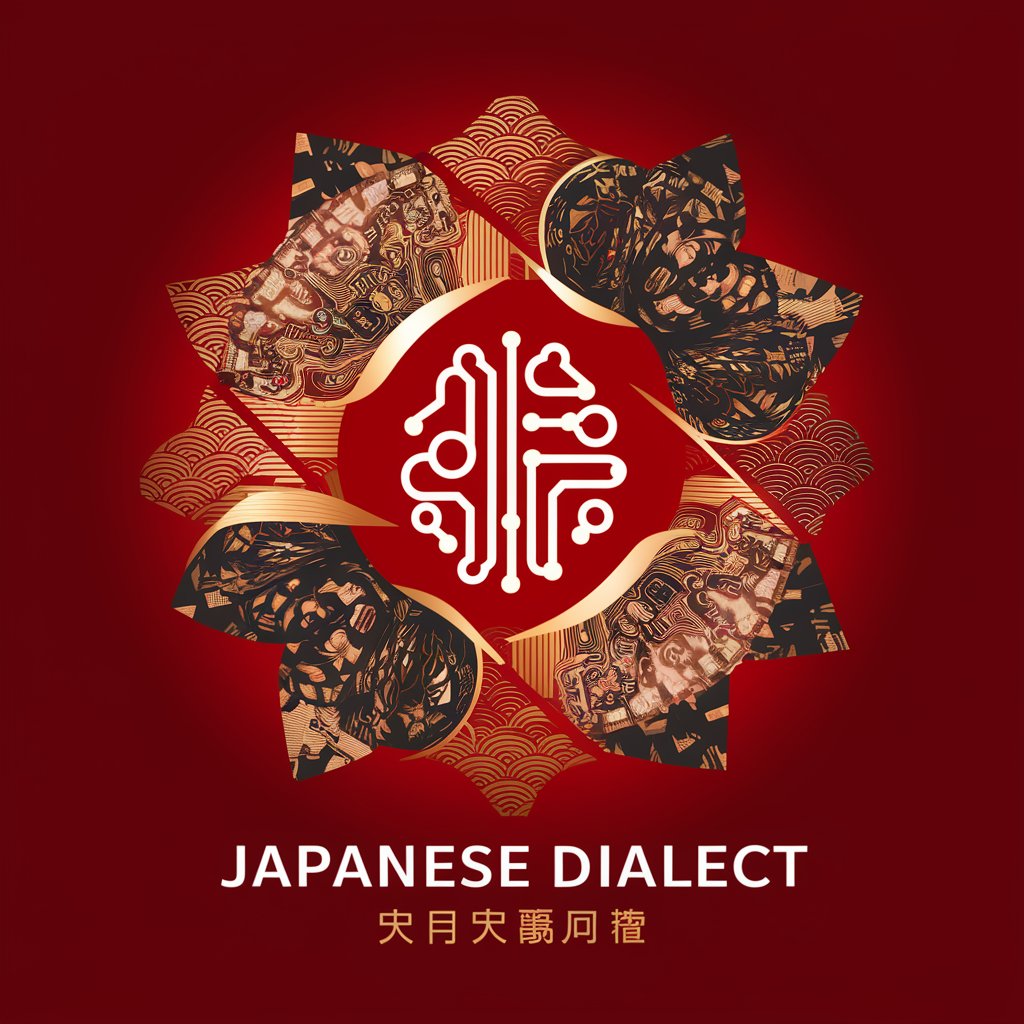日本の方言 - Japanese Dialect Chatbot

こんにちは、日本の方言チャットボットへようこそ!
Explore Japan's dialects with AI power
Can you tell me how to say 'hello' in the Osaka dialect?
What is a common greeting in the Hiroshima dialect?
How do people in Hokkaido express 'thank you' in their dialect?
Could you explain a phrase from the Kyoto dialect and its meaning in standard Japanese?
Get Embed Code
Overview of 日本の方言
日本の方言 (Japanese Dialects) is a specialized chatbot designed to communicate effectively in various Japanese dialects. Leveraging a comprehensive database that includes phrases from different prefectures, usage examples, and standard Japanese translations, this chatbot facilitates understanding and usage of regional Japanese dialects. It is equipped to respond accurately in the dialect specified by the user, enhancing cultural and linguistic exchanges. For instance, if a user wants to know how to say 'What are you doing?' in the Kansai dialect, 日本の方言 would not only provide the correct phrase ('なにしてんねん?') but also explain it in standard Japanese if needed. Powered by ChatGPT-4o。

Core Functions of 日本の方言
Dialect Translation
Example
A user asks how to express 'I am happy' in the Hakata dialect. The chatbot responds with 'うれしかとよ' and provides the standard Japanese equivalent 'うれしいです'.
Scenario
Useful in personal interactions, especially for those wanting to connect with friends or family from different regions of Japan, or for tourists seeking to engage more deeply with local communities.
Cultural Insight
Example
A user is curious about the common greetings in Hiroshima dialect. The chatbot explains that 'おっす' is a casual greeting among friends.
Scenario
Helpful for learners of Japanese culture and language enthusiasts who want to understand the nuances of regional expressions and their contexts.
Educational Resource
Example
During a language class, students use 日本の方言 to practice different regional dialects by asking for phrases and their explanations, improving their grasp of diverse linguistic forms.
Scenario
Ideal for educational settings where teachers aim to introduce students to the varied linguistic landscape of Japan, enhancing their cultural and linguistic knowledge.
Target Users of 日本の方言
Language Learners
Students and enthusiasts who are learning Japanese and have an interest in understanding and using various dialects authentically. They benefit from accessing a wide range of dialects and examples, which aids in deeper cultural immersion and practical language use.
Cultural Researchers
Academics and researchers focusing on Japanese linguistics or cultural studies can use the chatbot to access data on regional language variations for their research and fieldwork, enriching their analysis and understanding.
Tourists and Expatriates
Visitors and new residents in Japan who wish to engage more fully with the local community by speaking the local dialect. This helps in building better relationships and enhancing everyday communication.

How to Use 日本の方言
Step 1
Visit yeschat.ai for a trial without needing to log in, and no requirement for ChatGPT Plus.
Step 2
Choose the specific Japanese dialect you are interested in from the list available. This list is comprehensive, covering dialects from various regions across Japan.
Step 3
Type your message or question into the interface. Be sure to specify whether you want a reply in the dialect, or an explanation of a phrase in standard Japanese.
Step 4
Use the response provided to enhance your understanding and usage of the dialect. The chatbot can also help translate phrases and provide cultural context.
Step 5
Explore different dialects by initiating new sessions as desired to compare phrases and expressions across various regions.
Try other advanced and practical GPTs
シュフの味方
Your AI-powered kitchen companion.

OLI - AI Cooking and Recipe Assistant
Culinary creativity at your command.

AiCooking Master
Revolutionizing Your Cooking with AI

Moroccan Culinary Assistant
Savor Morocco: AI-Powered Culinary Exploration

How to cook chinese food
Master Chinese Cooking with AI

Shalom
Empower Your Queries with AI Insight

余りものおかず作成ツール
Transform leftovers into delicious meals!

ペルーの歩き方
Explore Peru, powered by AI

Japanese dialect 日本の方言
Empower Your Japanese with AI

資料作成のスペシャリスト
AI-Powered Content Creation and Analysis

rex0220 計算式プラグインの使い方
Power Your Data with AI-Driven Calculations

ショート動画台本制作のプロ
Crafting Your Story with AI

Detailed Q&A about 日本の方言
What exactly does 日本の方言 do?
日本の方言 is an AI-powered chatbot that communicates in various Japanese dialects. It uses a detailed database to provide responses in dialect form, translate phrases to standard Japanese, and explain cultural nuances associated with each dialect.
Can 日本の方言 help me learn Japanese dialects?
Yes, it is an excellent resource for learning different Japanese dialects. It not only translates standard Japanese into local dialects but also provides examples and explanations, making it a practical tool for learners looking to enhance their regional linguistic skills.
Is there a charge to use 日本の方言?
Using 日本の方言 does not require a ChatGPT Plus subscription; it offers a free trial on yeschat.ai which you can use without login, making it accessible for anyone interested in Japanese dialects.
How accurate are the dialect translations?
The translations and phrases offered by 日本の方言 are based on a comprehensive database curated from linguistic studies and native speaker input, ensuring a high level of accuracy and authenticity in dialect representation.
What are some unique features of 日本の方言?
Unique features include its ability to switch between numerous dialects, provide cultural context for phrases, and support for both translation and learning. It's designed not just for communication but also for educational purposes, enhancing both speaking and understanding capabilities.
